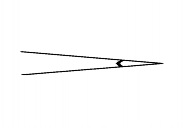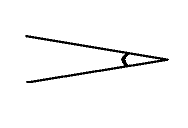Invisible Geometry
Invisible Geometry (also known as Lazy Geometry) was invented by Euclid in 300BC the day his pen ran out and he was forced to stop working on his "Elements" book. However, he soon discovered the great beauty and power of invisible geometry in the field of Applied Sloth, and in fact it was another three years before he reluctantly got around to finishing "Elements".
The five postulates of Invisible Geometry, and their applications[edit]
(1) The shortest distance between two points is to not bother going between them at all.[edit]
This first axiom illustrates the main reason why Invisible Geometry was suppressed by the educational system. It was somehow felt (by everyone but Euclid) that encouraging children to learn to "stay in bed all day because it is easier" was not as good as telling them the regular geometry rule about going everywhere in straight lines.
(2) A straight line cannot be extended forever without getting bored and wandering off, so why bother extending it at all?[edit]
The smart among you will actually have noticed that this axiom was not completely suppressed like the first, and in fact it is the major consideration in all of today's road network planning. The axiom tells road planners that their builders will eventually get bored if they have to go in a straight line for too long, so it is necessary to occasionally put in a redundant feature every so often, such as a speed-hump, a roundabout, or a city. Incidentally, Roman road builders (before Euclid) got around this problem by occasionally stopping building work on their dead straight roads to have another go at invading Scotland.
(3) Given a straight line, you could draw a circle with it as radius, if you had a compass. But who outside of a schoolteacher carts compasses around?[edit]
This axiom is perhaps the simplest, explaining as it does why we never see those hypothetical mathematical things called circles in real life.

|
| Postu... Prostu... Pro-po-stu... Prostate? 4 |
(4) All angles are the same, unless you have a protractor (see previous point).[edit]
You always knew deep down that trigonometry was pointless, didn't you? Well, here's why: all angles are inherently the same. For those who doubt me, draw two angles on two pieces of paper. Now tilt one of the pieces of paper, and you will find that if you do it right, the angle will change to match the angle on the second piece of paper.
(5) (Farewell Postulate) Given a point and a line, you can wander off and never meet either of them again.[edit]
This is also known as the Getting Lost Postulate - it is a direct result of this that makes it so very unlikely that you'll navigate successfully around an unfamiliar place (and not, contrary to popular belief, the fact that you won't stop and ask for directions).
Further developments[edit]
Later Euclid briefly worked on something he called Negative geometry, but his comments on this are rather vague, ranging from "Now, if the angle is empty then there's no fish.", which is still quite comprehensible, to "Crabs are still present, but the doctor may help me." It is unclear who was the doctor referenced (Prometheus has been suggested) having more insight on the matter.




